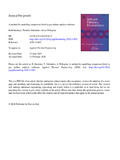JavaScript is disabled for your browser. Some features of this site may not work without it.
| dc.contributor.author | Hackney, Rick | |
| dc.contributor.author | Nikolaidis, Theoklis | |
| dc.contributor.author | Pellegrini, Alvise | |
| dc.date.accessioned | 2020-03-04T09:48:15Z | |
| dc.date.available | 2020-03-04T09:48:15Z | |
| dc.date.issued | 2020-02-17 | |
| dc.identifier.citation | Hackney R, Nikolaidis T, Pellegrini A. (2020) A method for modelling compressor bleed in gas turbine analysis software. Applied Thermal Engineering, Volume 172, May 2020, Article number 115087 | en_UK |
| dc.identifier.issn | 1359-4311 | |
| dc.identifier.uri | https://doi.org/10.1016/j.applthermaleng.2020.115087 | |
| dc.identifier.uri | https://dspace.lib.cranfield.ac.uk/handle/1826/15216 | |
| dc.description.abstract | The modelling of compressor interstage bleed in a gas turbine is required at all phases of the engine design cycle. The effect of the physical geometry of the bleed offtake on compressor flow is an important consideration, but of equal importance is the analysis of the effect of bleed air on compressor work requirements and overall gas turbine cycle efficiency. Knowledge of bleed air properties (temperature, pressure, work) is of paramount importance to carry out a reliable preliminary cycle analysis. While interstage bleed modelling may be regarded as a small detail in the overall gas turbine cycle, it is of increasing importance in modern engine design due to the requirement to obtain performance optimisation in engines that have already had significant development. Consequently, even small improvements to the modelling process can yield beneficial improvements to the engine cycle. Current methods to identify these effects vary in terms of complexity and accuracy; in this paper, a novel method is proposed, which offers an innovative -yet simple- way to simulate any number of interstage bleeds within a compressor, without the need to compromise on model accuracy. This is achieved through implementation of two methods - 1) properties of the bleed air are calculated by utilising the polytropic relationship between pressure and temperature, and 2) compressor work requirements are calculated by use of the ”superposition principle” by implementing the work requirements of the bleed into an initial ’no bleed’ calculation. This method has been implemented in the Cranfield modelling software Turbomatch, and validated against test data from an industrial gas turbine. Analyses so far show that the method is quick, accurate, and compares extremely well to the test data. This novel, ’integrated’ method has been shown to calculate interstage bleed properties in a gas turbine compressor without the need for complex modelling or artificial ’splitting’ of components. This method is partially dependent on the assumption that stage pressure ratio can be estimated using constant stage temperature rise and compressor overall polytropic efficiency (although the use of overall isentropic efficiency was also investigated). Case studies performed on a number of Siemens industrial gas turbines suggest this is indeed the case, with calculated stage inlet/outlet pressure typically within 3% of the real engine comparison, although older technology compressors tend to be modelled less accurately than newer ones. For compressor work and overall cycle calculation, comparison of this method against test data shows that accuracies between 0.5-1% can be obtained down to low load conditions. Compared to compressor ’splitting’ methods, which demonstrated relatively poor accuracy levels (above 20%), likely due to inaccurate compressor map selection, the alternative method is shown to be a suitable method to model bleed without the need for extensive manual model adjustment. It is also shown how this method can be used to quickly assess the effect of bleed stage and mass flow on the compressor running line, as well as on the surge margin. It should be noted that, while the engines used in the case study represent different engine designs and technology levels, they are from the same engine manufacturer and represent a gradual evolution of compressor technology using a similar design philosophy. | en_UK |
| dc.language.iso | en | en_UK |
| dc.publisher | Elsevier | en_UK |
| dc.rights | Attribution-NonCommercial-NoDerivatives 4.0 International | * |
| dc.rights.uri | http://creativecommons.org/licenses/by-nc-nd/4.0/ | * |
| dc.subject | Compressor | en_UK |
| dc.subject | Performance | en_UK |
| dc.subject | Modelling | en_UK |
| dc.subject | Bleeds | en_UK |
| dc.subject | Gas Turbine | en_UK |
| dc.title | A method for modelling compressor bleed in gas turbine analysis software | en_UK |
| dc.type | Article | en_UK |
Files in this item
The following license files are associated with this item:
This item appears in the following Collection(s)
-
Staff publications (SATM) [4360]

